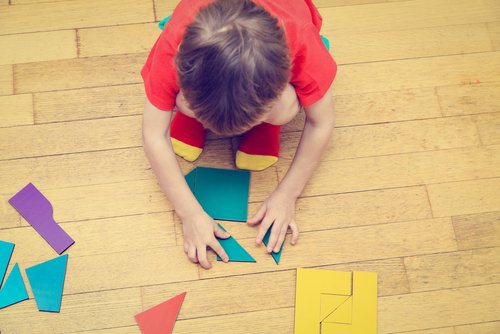7 Exercises that Improve Your Child's Ability to Pay Attention


Written and verified by lawyer Francisco María García
Children get distracted easily. They look around and just about anything catches and captures their attention. Honestly, this is normal.
But for their own good, we need to help them correct this and help them to maintain their focus. Improving the attention of children is a challenge that many parents share.
If a child talks a lot during class, can’t focus while doing his homework, or gets distracted when someone is talking to him, then something must be done.
If not, the child will internalize the negative behavior and become a distracted and careless teenager.
Your child’s future work and academic experiences will depend on his ability to concentrate. The good news is, there are exercises that we can implement to improve our children’s ability to pay attention and stay on task.
Believe it or not, we can even use play to resolve this small issue.
Some exercises to improve your child’s ability to focus
Visual association and memory games
Association games help teach little ones to create categories of things that are alike. Associating related figures or drawings requires focus and concentration.
And if we can manage to get our children to invest a good amount of time on these activities, then we will accustom them to pay attention.
There are games and magazines that follow this type of dynamic. Perhaps the activity that presents the greatest challenge are memory games.
Through memory games, children learn to train their field of perception – all while playing!

Completing drawings or connecting the dots
These types of activities are common in puzzle books. Children love them because they are simple and invite them to develop their artistic side. However, at the same time, these drawings allow children to work on their ability to focus.
Connect the dot activities are ideal because children must follow the directions. If not, they will not discover the final image. Their own curiosity serves as motivation to focus. As a result, unconsciously, children learn to stay on task.
Mazes
Mazes are another excellent alternative that we see among popular pastimes. They are sure to capture your child’s interest, but in order to be successful, she must pay attention. Mazes invite children to memorize and identify paths and openings inside the maze.
Mazes have their own rules and limits. They demand a certain level of discipline and, of course, attention. The purpose behind all of these activities is for the child to concentrate without getting bored.
Treasure hunt
A great activity for more active kids is creating a treasure hunt. Make a list of 3 or 4 objects that are scattered around the house. Once the list is made, ask your child to bring you the items from the list.
You can also challenge your child to bring you the objects in order. With time, you can make the game more challenging by adding more items to the list. You can also give him clues rather than directly naming the objects.
Establishing routines is one of the best ways to increase a person’s attention. As adults, we do this all the time, unconsciously.
Number identification
Numbers are a perfect abstraction for creating mental association games. “Identify the number” consists first of asking the child to memorize a number. Then, we list off several number figures, and the child must point out every time his selected number appears.

This dynamic game requires children to pay special attention while listening to the numbers. The same game can also be played using letters, according to the child’s preferences.
You can also use candy or some other snack to motivate your little one.
Ordering games
We can place several objects in a given order. The child must memorize the order before an adult mixes them up. The youngster must then put the objects back in order using a mental image or whatever other technique employed to memorize the original order.
There are board games that follow this organizational dynamic and require a great deal of application from the players to be successful. There are also games on the internet that fulfill the purpose of stimulating the mental organization of little ones.
“The greatest gift you can give to another is the purity of your attention”
–Richard Moss–
Jigsaw puzzles for improving a child’s ability to focus
No game requires more concentration than a jigsaw puzzle. Fortunately, there are plenty of difficulty levels on the market to fit the age and skills of all children.
Children as young as 2 or 3 years of age can enjoy puzzles with few, large pieces, with the help of their parents.
As you can see, simple nagging is not the only way – nor the best way – to get your little one to pay attention. The best strategy is to start working with your child as soon as possible so that their future academic life be much less complicated.
Children get distracted easily. They look around and just about anything catches and captures their attention. Honestly, this is normal.
But for their own good, we need to help them correct this and help them to maintain their focus. Improving the attention of children is a challenge that many parents share.
If a child talks a lot during class, can’t focus while doing his homework, or gets distracted when someone is talking to him, then something must be done.
If not, the child will internalize the negative behavior and become a distracted and careless teenager.
Your child’s future work and academic experiences will depend on his ability to concentrate. The good news is, there are exercises that we can implement to improve our children’s ability to pay attention and stay on task.
Believe it or not, we can even use play to resolve this small issue.
Some exercises to improve your child’s ability to focus
Visual association and memory games
Association games help teach little ones to create categories of things that are alike. Associating related figures or drawings requires focus and concentration.
And if we can manage to get our children to invest a good amount of time on these activities, then we will accustom them to pay attention.
There are games and magazines that follow this type of dynamic. Perhaps the activity that presents the greatest challenge are memory games.
Through memory games, children learn to train their field of perception – all while playing!

Completing drawings or connecting the dots
These types of activities are common in puzzle books. Children love them because they are simple and invite them to develop their artistic side. However, at the same time, these drawings allow children to work on their ability to focus.
Connect the dot activities are ideal because children must follow the directions. If not, they will not discover the final image. Their own curiosity serves as motivation to focus. As a result, unconsciously, children learn to stay on task.
Mazes
Mazes are another excellent alternative that we see among popular pastimes. They are sure to capture your child’s interest, but in order to be successful, she must pay attention. Mazes invite children to memorize and identify paths and openings inside the maze.
Mazes have their own rules and limits. They demand a certain level of discipline and, of course, attention. The purpose behind all of these activities is for the child to concentrate without getting bored.
Treasure hunt
A great activity for more active kids is creating a treasure hunt. Make a list of 3 or 4 objects that are scattered around the house. Once the list is made, ask your child to bring you the items from the list.
You can also challenge your child to bring you the objects in order. With time, you can make the game more challenging by adding more items to the list. You can also give him clues rather than directly naming the objects.
Establishing routines is one of the best ways to increase a person’s attention. As adults, we do this all the time, unconsciously.
Number identification
Numbers are a perfect abstraction for creating mental association games. “Identify the number” consists first of asking the child to memorize a number. Then, we list off several number figures, and the child must point out every time his selected number appears.

This dynamic game requires children to pay special attention while listening to the numbers. The same game can also be played using letters, according to the child’s preferences.
You can also use candy or some other snack to motivate your little one.
Ordering games
We can place several objects in a given order. The child must memorize the order before an adult mixes them up. The youngster must then put the objects back in order using a mental image or whatever other technique employed to memorize the original order.
There are board games that follow this organizational dynamic and require a great deal of application from the players to be successful. There are also games on the internet that fulfill the purpose of stimulating the mental organization of little ones.
“The greatest gift you can give to another is the purity of your attention”
–Richard Moss–
Jigsaw puzzles for improving a child’s ability to focus
No game requires more concentration than a jigsaw puzzle. Fortunately, there are plenty of difficulty levels on the market to fit the age and skills of all children.
Children as young as 2 or 3 years of age can enjoy puzzles with few, large pieces, with the help of their parents.
As you can see, simple nagging is not the only way – nor the best way – to get your little one to pay attention. The best strategy is to start working with your child as soon as possible so that their future academic life be much less complicated.
All cited sources were thoroughly reviewed by our team to ensure their quality, reliability, currency, and validity. The bibliography of this article was considered reliable and of academic or scientific accuracy.
- Aroca Barrios, M. A., & Delgadillo Parra, D. A. (2015). La lúdica como estrategia para mejorar los procesos de atención en los niños de grado primero del Colegio Americano de Ibagué. http://repository.ut.edu.co/handle/001/1416
- Cortes, N. (2021). El diseño y uso de rompecabezas como material didáctico para estimular la escritura y la lectura en los niños y niñas del grado kínder del colegio nuestra señora del rosario. https://repository.usta.edu.co/bitstream/handle/11634/42533/2022NellyCortes.pdf?sequence=7
- Riofrío Archuleta, M. C. (2013). El uso de gimnasia cerebral como estrategia de movimiento en el aula para mejorar la atención y concentración en clases de niños de tres años Un estudio de caso (Bachelor’s thesis, Quito, 2013). http://repositorio.usfq.edu.ec/handle/23000/2196
- Suarez-Manzano, S., Ruiz-Ariza, A., Lopez-Serrano, S., & López, E. J. M. (2018). Descansos activos para mejorar la atención en clase: intervenciones educativas. Profesorado, Revista de Currículum y Formación del Profesorado, 22(4), 287-304. https://185.79.129.77/index.php/profesorado/article/view/69423
This text is provided for informational purposes only and does not replace consultation with a professional. If in doubt, consult your specialist.








